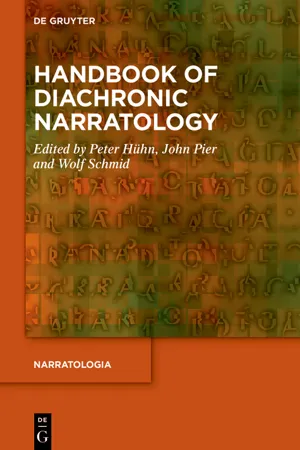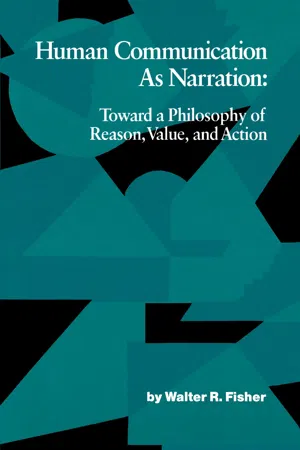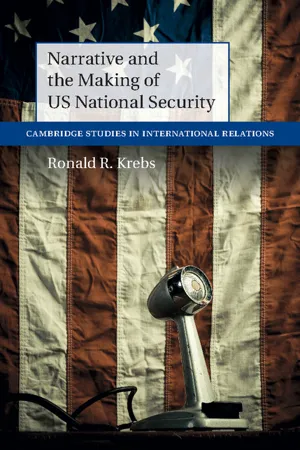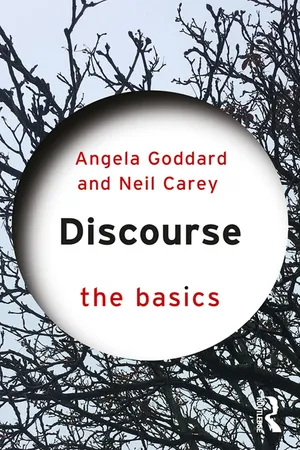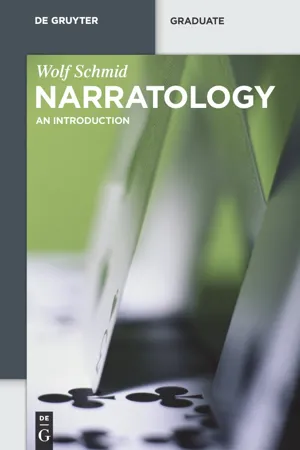Languages & Linguistics
Narration Rhetorical Mode
Narration is a rhetorical mode that involves telling a story or recounting a series of events. It is used to convey information, entertain, or persuade an audience. In narration, the focus is on the sequence of events and the development of characters, setting, and plot.
Written by Perlego with AI-assistance
Related key terms
1 of 5
7 Key excerpts on "Narration Rhetorical Mode"
- eBook - ePub
- Peter Hühn, John Pier, Wolf Schmid, Peter Hühn, John Pier, Wolf Schmid(Authors)
- 2023(Publication Date)
- De Gruyter(Publisher)
The Rhetoric of Narration in the Early Modern Period Christine Noille Note: Translated from the French by John Pier. 1 Definition The empire of rhetoric was not blind to narration, a term that transposed into modern French (from sixteenth to the nineteenth century) the Latin narratio, -onis, f., itself a translation of the Greek diègema (διήγημα, ατος, τὸ). Narration here is thus not understood in the sense proposed by Gérard Genette: “the producing narrative act” (1972, 72). 2 The Places of Narration in Rhetoric From the time of ancient Greece up to the age of literature (end of the nineteenth century), two stable and consequential bodies of writings were devoted to narration at two levels of the rhetorical system. On the one hand, narration, in the third subtechnique forming the ars oratoria, known as dispositio, constitutes one of the five specific parts of persuasive discourse alongside exordium, proof (or confirmation), refutation, and peroration. The standard definitions are found in the Rhetorica ad Herennium (1.8–9) and in Cicero’s Treatise on Rhetorical Invention (1.19–21.27–30), and they are repeated in Quintilian’s Institutio oratoria (4.2) as well as by all subsequent rhetoricians. On the other hand, narration is included among the fourteen “preliminary exercises” (progymnasmata) collected in the fourth century CE by Aphthonios (2008) and others. Starting in 1599 and for the next three centuries, it was transmitted throughout Europe thanks to the Jesuits’ ratio studiorum : the student worked on these exercises during the year prior to the study of rhetoric properly speaking, which was devoted to the Humanities. Thus, on the one hand, narration is a sophisticated syntagmatic device integrated into a larger discursive whole; on the other hand, it is an autonomous piece of writing open to variations that are more or less academic, more or less ingenious - eBook - PDF
Human Communication as Narration
Toward a Philosophy of Reason, Value, and Action
- Walter R. Fisher(Author)
- 2021(Publication Date)
- University of South Carolina Press(Publisher)
By narration, I mean symbolic actions-words and/or deeds-that have sequence and meaning for those who live, create, or interpret them. I agree with Alasdair Macintyre, who wrote: Man is in his actions and practice, as well as in his fictions, essentially a storytelling animal; 3 enacted dramatic nar-rative is the basic and essential genre for the characterisation of human actions. 4 So understood, narration has relevance to real as well as fictive creations, to stories of living and to stories of the imagination. The narrative paradigm can be considered a dialectical synthesis of two traditional strands that recur in the history of rhetoric: the argumentative, persuasive theme and the literary, aesthetic theme. The narrative paradigm implies that human communication should be viewed as historical as well as situational, as stories or accounts competing with other stories or ac-counts purportedly constituted by good reasons, as rational when the stories satisfy the demands of narrative probability and narrative fidelity, and as inevitably moral inducements. The narrative paradigm challenges the notions that human communication-if it is to be considered rhetori-cal-must be argumentative in form, that reason is to be attributed only to discourse marked by clearly identifiable modes of inference and implica-tion, and that the norms for evaluation of rhetorical communication must be rational standards taken exclusively from informal or formal logic. The paradigm I offer does not disregard the roles of reason and rationality; it expands their meanings, recognizing their potential presence in all forms of human communication. I should clarify the sense in which I use the term paradigm. By 58 As a Paradigm of Human Communication paradigm, I refer to a representation designed to formalize the structure of a component of experience and to direct understanding and inquiry into the nature and functions of that experience-in this instance, the experi-ence of human communication. - Ronald R. Krebs(Author)
- 2015(Publication Date)
- Cambridge University Press(Publisher)
In the two “matched” cases, the speaker’s 39 Special Message to the Congress on Greece and Turkey: The Truman Doctrine, 12 March 1947, available at The Public Papers of the President, American Presidency Project, www.presidency.ucsb.edu/ws/. Unless otherwise indicated, all further references to presidential speeches come from this source. Domination and the art of storytelling 41 rhetorical mode is properly aligned with the narrative situation: when the narrative situation is relatively settled and speakers employ argu- ment, and when that situation is relatively unsettled and speakers employ storytelling. While speakers have incentives to match their rhetorical mode to the narrative situation, they also sometimes deploy an inappropriate, or “mismatched,” rhetorical mode – due to stylistic preferences, the uncertainty endemic to political and social life, and simple error. These are Figure 2.1’s lower-left and upper-right cells: when the narrative situation is relatively unsettled and speakers turn to argument, and when the situation is relatively settled and speakers nevertheless focus on storytelling. This model embodying elements of structure (narrative situation) and agency (rhetorical mode) is a useful first-cut, but it does not take into account who is speaking (authority) or what they say (content). After laying out the dynamics of the sparer model, I explore both authority and content to generate more specific claims. 1. Contestation within dominant narrative: policy debate, rhetorical coercion. When the narrative situation is relatively settled and speakers employ argument, political contestation may be vigorous, but it is constrained: only those policies that can be legitimated within the terms of the prevailing narrative are sustainable.- eBook - ePub
Toward a Poetic Theory of Narration
Essays of S.-Y. Kuroda
- Sylvie Patron(Author)
- 2014(Publication Date)
- De Gruyter Mouton(Publisher)
Chapter 3Reflections on the foundations of narrative theory, from a linguistic point of view 168
1 The communicational theory of narration
1.1
It is a widely held view that language (langage ) is a phenomenon of communication. A specific language as a system of knowledge (langue ) would then be a system of code; each sentence would be a code for a minimum unit of message. An occurrence of a sentence in speech (parole 169 ) would represent a unit message to be communicated by the addressor to the addressee by means of this communication system.A unit message to be represented by a sentence, in this conception of language, is the content of a mental act of judging, wishing, etc. We are not concerned with a systematic taxonomy of the mental acts that underlie such sentence uses in linguistic performance. It suffices for our present purposes to characterize the mental act underlying the use of a sentence as an act of judging or a modification of it in some sense or other. The substantive content of such an act of judging, genuine or modified, is an event, or a state of affairs, real, imagined, wished, etc. For the sake of simplicity of exposition, in what follows I shall in general write as if a sentence used in speech performance in communication is an expression for the content of an act of judging, leaving possible modifications of such acts to be understood implicitly.A theory of language must include both a theory of linguistic performance and a theory of linguistic competence.170 - eBook - PDF
- Angela Goddard, Neil Carey(Authors)
- 2017(Publication Date)
- Routledge(Publisher)
CRITICAL LINGUISTICS The discussion above focused largely on narrative in fiction but, as has already been suggested throughout this book, texts come in all shapes and sizes and they all have their own way of con- structing a sense of reality. The same is true of narratives. It was useful to illustrate point of view by using a piece of published 135 DISCOURSE AND NARRATIVE fiction but narratives can be seen in operation way beyond the fiction shelves. Toolan (2001) describes his work on narrative as Critical Linguistics, by which he means an analysis that has a deliberate focus on issues of power and representation, and that attempts to lay bare the ideology that lies behind any narrative. Although he analyses some literary texts, he also shows how news narratives work, focusing on some of the language structures that help to shape the perspectives of readers. Similar work has been done on the language of newspaper stories by academics working within the field of Critical Discourse Analysis (CDA): for example, see Fairclough (2010). There are many different language items and structures that could be associated with how a story is told – in other words, its narrative orientation. The previous two sections referred to differ- ent aspects of point of view, and these can be seen in operation in news headlines and articles every day, playing their part in con- structing an ideology. And seemingly trivial language items such as pronouns can be usefully vague in setting up powerful positions. For example, if a newspaper headline uses ‘we’, it is often unclear who ‘we’ are: is it the news proprietors and the journalists, or does it include the notional readers, assuming that they all share the paper’s values? Equally vague are references to ‘us’ and ‘them’, where ‘they’ might be any group of people who are regarded by the newspaper’s owners and editorial team as different from themselves and their readership – as ‘other’. - eBook - PDF
- Christiana Gregoriou(Author)
- 2017(Publication Date)
- Red Globe Press(Publisher)
CHAPTER Narrators, Viewpoint, 4 Speech and Thought ❚ 4.1 Narratives: some introductory terminology Narratives code experience and can be said to be constructions of reality. We often use narratives to recount personal experiences or construct fictional ones, in order to inform and/or entertain. They help us relate to others and build various bonds among us, express our feelings and deal with situations around us, in the course of our everyday lives. Oral narratives differ from written narratives in a number of ways. Some oral narratives are indeed fictional (such as jokes), but by and large, oral narratives tend to relate personal experience and are in fact chronologically ordered (see Labov, 1972; Labov and Waletsky, 1967). On the other hand, even though some written narratives are also based on personal experiences (such as autobiogra-phies), most literary written narratives are fictional and said to be the non-temporarily ordered discourse of an explicit or implicit narrator who tells us about events in a so-called ‘world’. It is for this reason that analysts have consis-tently persisted in making a distinction between ‘plot’ and ‘discourse’. The term plot is generally understood to refer to the basic story-line of the narrative; in other words, the sequence of elemental, chronologi-cally-ordered events which generate a narrative. Narrative discourse, by contrast, encompasses the manner or means by which the plot is narrated. Narrative discourse, for example, is often characterised by stylistic devices such as flashback, prevision and repetition – devices which all disrupt the basic chronology of a story. (Simpson and Montgomery, 1995: 141) In short, ‘plot’ is the crude story-line material which the writer moulds into an artistic narrative design, the discourse. The Russian Formalists (notably Shklovsky, 1925) introduced the alternative pair of terms, ‘fabula’ and ‘sju ž et’, in the 1920s. - eBook - PDF
- Wolf Schmid, Alexander Starritt(Authors)
- 2010(Publication Date)
- De Gruyter(Publisher)
(Friedemann 1910, 26) Many theories of the more recent past have continued to describe the dis-tinctive nature of narrative in terms of a mediation process. Franz Stanzel, for example, begins his Theory of Narrative (Stanzel 1979; tr. 1984), in which he summarizes his earlier works (Stanzel 1955, 1964) against the back-ground of new theoretical horizons, by reaffirming mediacy ( Mittelbarkeit ) as the defining characteristic of narrative texts. He thereby renews the status 2 I. Features of narrative in fiction of a property that he had previously invoked as the indispensable defining feature of narration in the introduction to his Narrative Situations in the Novel (Stanzel 1955; tr. 1971). The second concept of narrativity was developed in the structuralist study of narrative, for which Tzvetan Todorov (1969) coined the term nar-ratology . In structuralism, the defining characteristic of narrative is not a fea-ture of discourse or communication but rather a feature of what is narrated. Texts that we describe as narrative in the structuralist sense of the word contrast with descriptive texts in that they contain a temporal structure and represent changes of state. The classical concept restricts narrativity to the domain of verbal com-munication, covering only those works containing a narrating authority, or mediator, including purely descriptive sketches and travel reports, while ex-cluding all lyric, dramatic, and cinematic texts. The structuralist concept, on the other hand, can apply to a representation in any medium, but excludes representations whose referents do not have a temporal structure and con-sequently do not contain any changes of state. Thus, drama and lyric poetry are also narrative, in so far as changes of state are portrayed in them.
Index pages curate the most relevant extracts from our library of academic textbooks. They’ve been created using an in-house natural language model (NLM), each adding context and meaning to key research topics.
